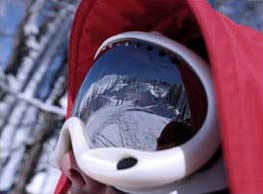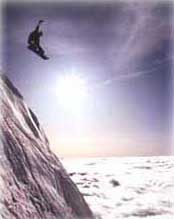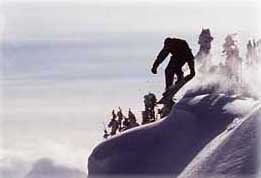Learn more about
 Your Responsibility Code
Your Responsibility Code
 Ski Tips for Kids
Ski Tips for Kids
 Premiers Secours aux Skieurs
Premiers Secours aux Skieurs
 Sun Safety
Sun Safety
 Strong Winds Stopping Chairlifts
Strong Winds Stopping Chairlifts
 Avalanches, Better Safe Than Sorry
Avalanches, Better Safe Than Sorry
Some sun exposure is good; besides tanning, it allows your body to manufacture Vitamin D, which helps calcium absorption. However, recently, there has been a legitimate concern over sun exposure due to increased risks of skin cancer. Skin cancer is the most common form of cancer in the world and accounts for approximately 1% of all cancer deaths. There are other good reasons to avoid excessive sun exposure other than avoidance of cancer. Wrinkles, premature aging, and cataracts may all be associated with overexposure to the sun. Recent research has shown that this aging effect is multiplied when the individual also smokes cigarettes.  Specifically it is the high energy ultraviolet rays ("UV") in sunlight that is the damaging portion of the sunlight because they cause free radical formation and cross linkage of your collagen. An analogy would be looking at old tires that have been out in the sun - they get cracked and brittle. UV has two major components UVA and UVB distinguished by their difference in wavelengths.
Specifically it is the high energy ultraviolet rays ("UV") in sunlight that is the damaging portion of the sunlight because they cause free radical formation and cross linkage of your collagen. An analogy would be looking at old tires that have been out in the sun - they get cracked and brittle. UV has two major components UVA and UVB distinguished by their difference in wavelengths.It was initially thought that only UVB was responsible for sun burning and cancer, however it is now known that UVA can also be damaging. Therefore a good sunscreen should afford protection against UVA and UVB. When in an outdoor location exposure can vary due to time of day, cloud cover, reflected light, and time of year. These variables should be taken into account when out in the sun. This is especially true when near bodies of water. A highly reflective surface like snow can augment the exposure by an additional 85%. Also areas which are high in elevation have less atmosphere to screen the UV rays and one will burn easier. Clouds do decrease the amount of sun exposure, but UV is still transmitted, and many people end up with a burn despite overcast skies. The Ozone layer of the atmosphere absorbs UV and it has been noted that it has decreased by 10% in the last 20 years. Of course, merely exposure to the sun is not the entire story.
 The effects are dependent on you, your level of pigmentation, how much of a tan you already have as well as the nature of your skin. Production of your skin's pigment, or melanin, is stimulated by sun exposure and does reduce your risk of sunburn once you are already tan. Be aware that even dark skinned individuals can be sunburned and damage their skin with over exposure. Obviously fair skinned individuals need to exercise more caution. Remember it is not the temperature outside that tans you, it is the intensity of the rays. Most of you who ski are well aware that you can get your face sunburned even in the winter time. Also be aware that there are certain drugs which can make you more susceptible to sun exposure, like RetinA and Tetracycline.
The effects are dependent on you, your level of pigmentation, how much of a tan you already have as well as the nature of your skin. Production of your skin's pigment, or melanin, is stimulated by sun exposure and does reduce your risk of sunburn once you are already tan. Be aware that even dark skinned individuals can be sunburned and damage their skin with over exposure. Obviously fair skinned individuals need to exercise more caution. Remember it is not the temperature outside that tans you, it is the intensity of the rays. Most of you who ski are well aware that you can get your face sunburned even in the winter time. Also be aware that there are certain drugs which can make you more susceptible to sun exposure, like RetinA and Tetracycline.Sunscreens available currently have a wide variety of ingredients which are effective in blocking UVA and UVB rays, and might also block out the sun. The most important thing for you as a consumer to look for is if they block both UVA and UVB. Other relevant factors are whether they are waterproof and the sun protection factor ("SPF"). The SPF is supposed to be an indicator as to how effective a sunscreen is. For example a sunscreen with an SPF of 10 is purportedly giving you protection such that 10 hours of sun will only give you 1 hours worth of exposure. Be very cautious when using this logic. Just be aware that the higher the SPF the more protection you have. Most dermatologists are now recommending SPF 15. Also remember that rubbing, sweating and swimming all wash off sunscreen, even if it is waterproof. Also if you use waterproof sunscreen, apply it at least 20 minutes before swimming and don't forget to reapply this at intervals of every 60-80 minutes.
Some individuals are sensitive to certain sunscreens, especially those containing the PABA ingredient. If a sunscreen irritates your skin, try another type with different ingredients. Also keep sunscreen from getting near your eyes. Researches made do not indicate that more expensive sunscreens are any more effective than their less expensive counter parts. Check the SPF.
 Clearly one obvious way not to get too much sun is to use protective devices like clothing, hats, and sunglasses. Make sure your sunglasses block both UVA and UVB also. Wrap around and larger glasses give your eyes even more protection. Also individuals who get oral herpes or cold sores should be cognizant that UV stimulates these episodes.
Clearly one obvious way not to get too much sun is to use protective devices like clothing, hats, and sunglasses. Make sure your sunglasses block both UVA and UVB also. Wrap around and larger glasses give your eyes even more protection. Also individuals who get oral herpes or cold sores should be cognizant that UV stimulates these episodes.Use a very high SPF on your mouth nose and chin area to afford protection even with brief periods of exposure. Exposure to the sun, of course can dry out your skin. It is recommended to use moisturizing lotions after bath and to apply it more than once if you do get sun burned.
REMEMBER: Take care of your skin, it reflects your age and health. There is nothing wrong with getting some sun, but remember that moderation is important, you'll have that skin the rest of your life.





